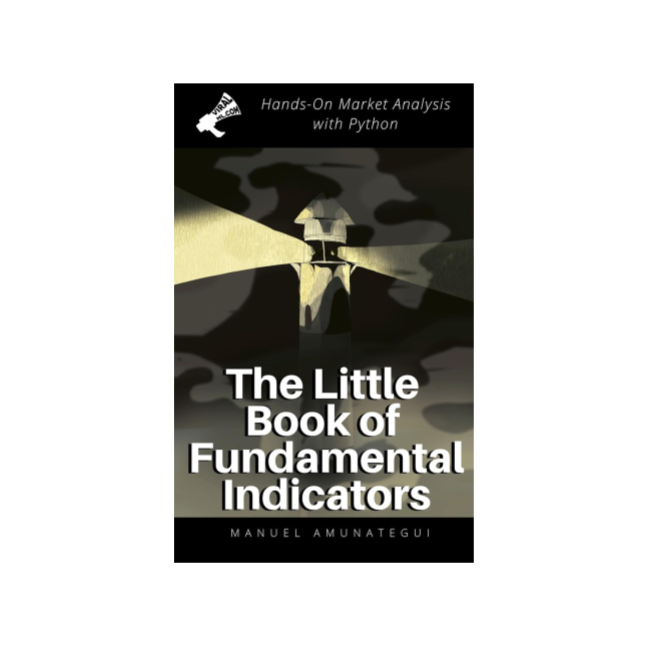
Employment and Labor Force Big Divergence - What's Going On? Hands-On Market Analysis with Python
Introduction
We are seeing some of the lowest unemployment in 50 years yet the highest drop in the labor force. Let's investigate this ourselves by finding the correct data sets and survey results to shed light on this weird phenomenon.
Code
from IPython.display import Image
Image(filename='viralml-book.png')
"50 year low in unemployment rate with nearly 100 million not in the labor force🤔" -- @NorthmanTrader¶
https://twitter.com/NorthmanTrader/status/1180556099239448577
Good read - Persons not in the labor force by desire and availability for work, age, and sex:
https://www.bls.gov/web/empsit/cpseea38.htm
Data Needed to Follow Along¶
From the Federal Reserve Bank of St. Louis¶
Not in Labor Force (LNS15000000)¶
https://fred.stlouisfed.org/series/LNS15000000
The series comes from the 'Current Population Survey (Household Survey)'
Unemployment Rate (UNRATE)¶
https://fred.stlouisfed.org/series/UNRATE
The unemployment rate represents the number of unemployed as a percentage of the labor force. Labor force data are restricted to people 16 years of age and older, who currently reside in 1 of the 50 states or the District of Columbia, who do not reside in institutions (e.g., penal and mental facilities, homes for the aged), and who are not on active duty in the Armed Forces.
From the Yahoo Finance¶
S&P 500 (^GSPC)¶
%matplotlib inline
import matplotlib
import matplotlib.pyplot as plt
import io, base64, os, json, re
import pandas as pd
import numpy as np
import datetime
import warnings
warnings.filterwarnings('ignore')
path_to_market_data = '/Users/manuel/Documents/financial-research/market-data/2019-10-07/'
Load Data¶
# Load Not in Labor Force data
not_labor_force_df = pd.read_csv(path_to_market_data + 'LNS15000000.csv')
not_labor_force_df.columns = ['Date', 'NotInLaborForce']
not_labor_force_df['Date'] = pd.to_datetime(not_labor_force_df['Date'])
print(np.min(not_labor_force_df['Date'] ),np.max(not_labor_force_df['Date'] ))
not_labor_force_df = not_labor_force_df.sort_values('Date', ascending=True) # sort in ascending date order
nil()
ot_labor_force_df.ta
# Load Unemployment Rate data
unemployment_df = pd.read_csv(path_to_market_data + 'UNRATE.csv')
unemployment_df.columns = ['Date', 'UnemploymentRate']
unemployment_df['Date'] = pd.to_datetime(unemployment_df['Date'])
print(np.min(unemployment_df['Date'] ),np.max(unemployment_df['Date'] ))
unemployment_df = unemployment_df.sort_values('Date', ascending=True) # sort in ascending date order
unemployment_df.tail()
# Load S&P 500 Index data
gspc_df = pd.read_csv(path_to_market_data + '^GSPC.csv')
gspc_df['Date'] = pd.to_datetime(gspc_df['Date'])
gspc_df = gspc_df[['Date', 'Adj Close', 'Volume']]
gspc_df.columns = ['Date', 'SP500_Close', 'SP500_Volume']
gspc_df = gspc_df.sort_values('Date', ascending=True)
print(min(gspc_df['Date']), max(gspc_df['Date']))
print(gspc_df.shape)
gspc_df.tail()
Join all data together¶
cut_off_date = '1975-01-01'
tmp_not_labor_force_df = not_labor_force_df.copy()
tmp_not_labor_force_df = tmp_not_labor_force_df[tmp_not_labor_force_df['Date'] >= cut_off_date]
tmp_unemployment_df = unemployment_df.copy()
tmp_unemployment_df = tmp_unemployment_df[tmp_unemployment_df['Date'] >= cut_off_date]
tmp_gspc_df = gspc_df.copy()
tmp_gspc_df = tmp_gspc_df[tmp_gspc_df['Date'] >= cut_off_date]
# join into single data frame
together_df = pd.merge(tmp_gspc_df,
tmp_unemployment_df, on= ['Date'], how='left')
together_df = pd.merge(together_df,
tmp_not_labor_force_df, on= ['Date'], how='left')
# last valid observation forward
together_df = together_df.fillna(method='ffill')
together_df.tail()
Plot the results¶
fig, ax = plt.subplots(figsize=(16, 8))
together_df.plot(subplots=True, ax=ax)
fig, ax = plt.subplots(figsize=(16, 8))
plt.plot(together_df['Date'],
together_df['UnemploymentRate'], color='red', label='Unemployment Rate')
plt.grid()
plt.title("Unemployment Rate & Not in Labor Force")
plt.legend(loc='upper left')
# Add independent y axis
ax.twinx()
plt.plot(together_df['Date'],
together_df['NotInLaborForce'] , color='blue', label='Not in Labor Force')
plt.legend(loc='upper right')
plt.show()
fig, ax = plt.subplots(figsize=(16, 8))
plt.plot(together_df['Date'],
together_df['UnemploymentRate'], color='red', label='Unemployment Rate')
plt.grid()
plt.title("Unemployment Rate & Not in Labor Force")
plt.legend(loc='upper left')
# Add independent y axis
ax.twinx()
plt.plot(together_df['Date'],
together_df['NotInLaborForce'] , color='blue', label='Not in Labor Force')
plt.legend(loc='upper right')
# Add independent y axis
ax.twinx()
plt.plot(together_df['Date'],
together_df['SP500_Close'] , color='black', label="S&P 500")
plt.legend(loc='lower right')
plt.show()
fig, ax = plt.subplots(figsize=(16, 8))
plt.plot(together_df['Date'],
together_df['UnemploymentRate'], color='red', label='Unemployment Rate')
plt.grid()
plt.title("Unemployment Rate & Not in Labor Force")
plt.legend(loc='upper left')
# Add independent y axis
ax.twinx()
plt.plot(together_df['Date'],
together_df['NotInLaborForce'] , color='blue', label='Not in Labor Force')
plt.legend(loc='upper right')
# Add independent y axis
ax.twinx()
plt.plot(together_df['Date'],
together_df['SP500_Volume'] , color='black', linewidth=0.2, label="S&P 500")
plt.legend(loc='lower right')
plt.show()
Show Notes
(pardon typos and formatting -these are the notes I use to make the videos)
We are seeing some of the lowest unemployment in 50 years yet the highest drop in the labor force. Let's investigate this ourselves by finding the correct data sets and survey results to shed light on this weird phenomenon.



